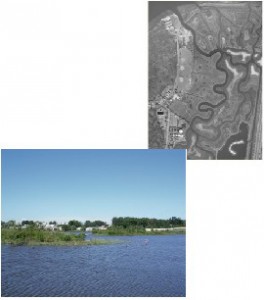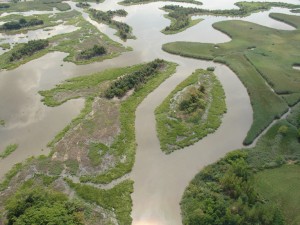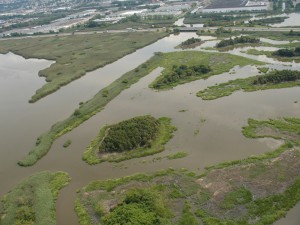Category: Waterbodies & Other Wetlands 
Location: Located east of the Hackensack River, in Secaucus, Hudson County. It runs along Mill Creek Wetland Mitigation Site, Petrillo Tract, Secaucus Tract, and Western Brackish Marsh before it outlets into the Hackensack River.
Current Land Use: Open Water
Site Description: Mill Creek is a meandering tidal creek with several oxbows. It is the main waterbody that flows into the Mill Creek Marsh owned by NJMC. The Secaucus Sewage Treatment Plant releases large quantities of tertiary-level treated freshwater into the creek, lowering salinity levels. Un-enhanced portions of the bank are dominated by common reed (Phragmites australis), while a variety of aquatic species have established along the enhanced marsh areas.
Existing Site-Specific Data Inventory
A. Survey, Maps, and GIS
HMD regional data exists inclusive of this site.
B. Real Estate/Ownership
N/A
C. Site History & Land Use
General land use data was included in an ecological management plan for the HMD from 1978.
D. Biological Studies – Fauna
A comparison fisheries study was conducted in 2002. General data was collected for a report on the effects of the Kearny Generating Station in 1988.
E. Biological Studies – General Environmental
A nitrogen study was done in 1974. General wetlands data was included in an ecological management plan for the HMD from 1978.
F. Geotechnical
No data obtained.
G. Hydraulics and Hydrology
No data obtained.
H. Water and Sediments
Various water quality studies were completed from 1974 to 2002. A sediment analysis was completed in 2001.
I. Historical/Cultural Resources
No data obtained.
J. Restoration/Remediation Design Plans
No data obtained.
Site Reports
Site #38 – Mill Creek
Category: Waterbodies & Other Wetlands
Location: Located east of the Hackensack River, in Secaucus, Hudson County. It runs along Mill Creek Wetland Mitigation Site, Petrillo Tract, Secaucus Tract, and Western Brackish Marsh before it outlets into the Hackensack River.
Current Land Use: Open Water
Site Description: Mill Creek is a meandering tidal creek with several oxbows. It is the main waterbody that flows into the Mill Creek Marsh owned by NJMC. The Secaucus Sewage Treatment Plant releases large quantities of tertiary-level treated freshwater into the creek, lowering salinity levels. Un-enhanced portions of the bank are dominated by common reed (Phragmites australis), while a variety of aquatic species have established along the enhanced marsh areas.
Existing Site Specific Data Inventory
* – Report repeated under multiple data categories and/or sites.
A. Survey, Maps, and GIS
Relevant survey, mapping, and GIS data for the Meadowlands can be found in the Meadowlands-wide site report under data category A.
B. Real Estate/Ownership
Not applicable.
C. Site History & Land Use
1. *Mattson, C. P. Ecological and Resource Management Plan for the Hackensack Meadowlands. 1978. [1a]A synopsis of what the then eight-year-old HMDC had learned about the Hackensack Estuary. Section 1 is an ecological primer, Section 2 provides information on the state of the estuary, and Section 3 presents natural resource management strategies for wetlands, water quality, open space, and land use planning.
D. Biological Studies – Fauna
2. *Able, Kenneth W., Melissa J. Neuman, & Ruess Guillermo (Rutgers University). The Influence of Low Dissolved Oxygen on Predatory Fishes: Comparisons between Restored and Impacted Marsh Creeks in the Hackensack Meadowlands. 2002.[1a] A study to determine patterns in water quality indicators and predatory fish use, and examine food habits of the dominant fish predators in two tidal marshes, Mill Creek Marsh (impacted natural creek) and Doctor’s Creek (a restored/created creek that is part of Marsh Resources Wetland Mitigation Bank).
3. *EA Science and Technology & PSE&G. Kearny Generating Station Supplemental 316(b) Report. NJDEP. 1988. [1a] Evaluates the effects of the cooling water intake of the Kearny Generating Station on the ecology of the Hackensack River and adjacent waters, based on entrainment and impingement data collected from June 1987 to April 1988, and on biological data collected from the vicinity of the Kearny station since August 1986. Studies of macrozooplankton, ichthyoplankton, and juvenile and adult fish were conducted in vicinity of the station and the full length of the estuary. Includes background information on the Hackensack Estuary.
E. Biological Studies – General Environmental
4. *Mattson, C. P. Ecological and Resource Management Plan for the Hackensack Meadowlands. 1978. [1a]A synopsis of what the then eight-year-old HMDC had learned about the Hackensack Estuary. Section 1 is an ecological primer, Section 2 provides information on the state of the estuary, and Section 3 presents natural resource management strategies for wetlands, water quality, open space, and land use planning.
5. *Trattner, R., A. Hernadez, V. Lasher, D. Voight, C.P. Mattson, D. Smith, F. Platt, & M. Saks. Nitrogen Budget Determination for a Selected Site in the Hackensack Meadowlands Estuary. November 1974. [4] Quantified a nitrogen budget for the Mill Creek drainage basin in the Secaucus area in order to determine whether wetlands in the Meadowlands can utilize the nitrogen load that passes over and through them.
F. Geotechnical
No data obtained.
G. Hydraulics and Hydrology
No data obtained.
H. Water and Sediments
6. *Able, Kenneth W., Melissa J. Neuman, & Ruess Guillermo (Rutgers University). The Influence of Low Dissolved Oxygen on Predatory Fishes: Comparisons between Restored and Impacted Marsh Creeks in the Hackensack Meadowlands. 2002.[1a] A study to determine patterns in water quality indicators and predatory fish use, and examine food habits of the dominant fish predators in two tidal marshes, Mill Creek Marsh (impacted natural creek) and Doctor’s Creek (a restored/created creek that is part of Marsh Resources Wetland Mitigation Bank).
7. *Anonymous (HMDC). Biological Water Quality and Field Sampling Survey of the Hackensack Meadowlands. 1980. [1a]During a one-day sampling event, water quality was measured at 11 sites for temperature, salinity, DO, and TSS. Also set fish sampling nets in Berry’s Creek Canal and Sawmill Creek.
8. *Anonymous. Nitrogen Budget Determination for a Selected Site in the Hackensack Meadowlands Estuary. 1974 [1a] Water velocity, DO, salinity, and temperature were monitored in Mill Creek. Samples were collected and analyzed for nitrate, nitrite, and kjeldahl nitrogen. Samples were also collected from the Secaucus Sewage Treatment Plant and compared to Mill Creek samples.
9. *Bopp, R. F. Radionuclide Analysis of Mill Creek and Saw Mill Creek Sediment Samples. 2001. [1a] Pb 210 and Cs 137 dating of four sediment cores from Mill Creek and one from Sawmill Creek, ranging from 18 to 26 centimeters deep, were collected in 1999. All data from Mill Creek supported the trace-metal-based hypothesis that the more consolidate clay mud is old (pre-industrial) sediment, and organic-rich upper layers represent recent deposition that occurred since site manipulation. In the Sawmill Creek core, no Pb or Cs isotopes were found.
10. *Gunawardana, Vajira K., Po-Shu Huang, Tavit O. Najarian, & Rhomaios V. Ram. Impact Analysis of Sewage Treatment Plant Discharges of the Water Quality of the Lower Hackensack River. June 1992. [1] Analyzed the impacts of discharge from BCUA treatment plant on the dissolved oxygen regime of the lower Hackensack River. The three tributaries that were selected for this study were Sawmill Creek, Berry’s Creek, and Mill Creek.
11. *Konsevick, Edward, Christine Cheng Hobble, & Paul Lupini. Monitoring Effects of Urban Land Use of Esturine Water Quality, Hackensack Meadowlands District, New Jersey. November 1994. [1] In 1993, the USGS, in cooperation with the HMDC, established a network of 14 ambient water monitoring sites, including the Hackensack River, Berry’s Creek, Penhorn Creek, Sawmill Creek, Mill Creek, and Cromakill Creek, to characterize the current status of water quality in the HMD. Salinity, DO, fecal coliform, pH, TSS, turbidity, total phosphorous, ammonia, sulfate, BOD, COD, heavy metal concentrations were measured at each of the monitoring sites.
12. *Mattson, C. P. Ecological and Resource Management Plan for the Hackensack Meadowlands. 1978. [1a]A synopsis of what the then eight-year-old HMDC had learned about the Hackensack Estuary. Section 1 is an ecological primer, Section 2 provides information on the state of the estuary, and Section 3 presents natural resource management strategies for wetlands, water quality, open space, and land use planning.
13. *Mattson, C., G. Potera, & M.E. Saks. Water Quality in a Disordered Ecosystem: A Report on the Water Quality Monitoring Study Performed in the Hackensack Meadowlands between June and September 1971. 1971. [1a] Part of a natural resource inventory on which to base future land use decisions and against which to make future comparisons. Chemistry and water quality were measured at 11 sites, including Berry’s Creek, Penhorn Creek, Losen Slote Creek, Bellman’s Creek, Moonachie Creek, Mill Creek, and the Hackensack River.
14. *Trattner, R., A. Hernadez, V. Lasher, D. Voight, C.P. Mattson, D. Smith, F. Platt, & M. Saks. Nitrogen Budget Determination for a Selected Site in the Hackensack Meadowlands Estuary. November 1974. [4] Quantified a nitrogen budget for the Mill Creek drainage basin in the Secaucus area in order to determine whether wetlands in the Meadowlands can utilize the nitrogen load that passes over and through them.
I. Historical/Cultural Resources
No data obtained.
J. Restoration/Remediation Design Plans
No data obtained.
K. Bibliographic Updates
Site #38: Mill Creek
Additional Images


